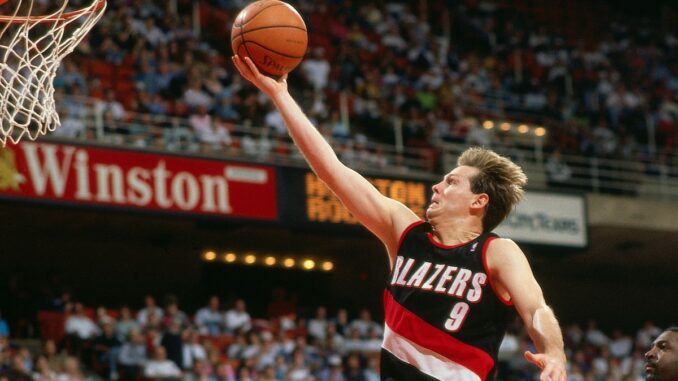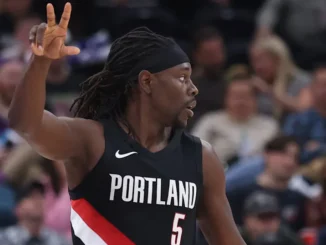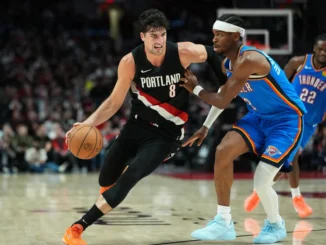
If you caught the first edition of our Top 50 Portland Trail Blazers All-Time Player Rankings, two things are true about you:
- You’re on the edge of your seat, waiting for Nos. 40-31
- You’re sick of “Center” talk
In Part 1, we ranked Nos. 50-41, five of whom were true centers. We also hit one C/PF, as well as two other power forwards. That’s a lot of big men packed into ten players.
In part 2, we’re ready to go “small ball.”
*Check out Part 1 of OSN’s All-Time Trail Blazers Player Ranking to review our complete voting method.
Portland Trail Blazers All-Time Top 50 Player Rankings
Nos. 50-41
50. Robin Lopez, C
49. Dave Twardzik, PG
48. Joel Przybilla, C
47. Kenny Carr, PF
46. Kermit Washington, PF
45. Tom Owens, C/PF
44. Sam Bowie, C
43. Dale Davis, C
42. Steve Johnson, C
41. Steve Blake, PG
*Click here to read about Nos. 50-41.
Nos. 40-31
*Note: All stats listed below apply only to a player’s time in Portland.
40. Billy Ray Bates, SG
Years: 1979-1982
Games Played: 168
PPG: 12.3
RPG: 1.8
APG: 2.0
SPG: 0.8
HI RK: 25
LO RK: Unranked
Billy Ray Bates was something of an antithesis when it came to the Trail Blazers’ style of play at the time. He was a pound-the-rock player who’d dribble the air out of the ball to score two points. Of course, that’s not to say it was a problem.
You see, Portland needed a shakeup by 1979. Whether it had asked for one or not, the team was at the beginning of a post-championship lull and rebuild. And while Bates never became the face of the franchise, he did, in many ways, represent an era of change.
After starting on just a 10-day contract, Bates became an instant crowd-pleaser. He had an above-the-rim style, which, at just 6’4”, energized the Veterans Memorial Coliseum crowd nightly.
His career-high 40 points was also, fittingly, against San Diego, who’d landed Bill Walton after his Trail Blazers departure.
Rates’ peak stretches may have come in the postseason, where he averaged 25 points per game in 1980 and 28.3 points per game in 1981. But more than anything, Billy Ray was a spark plug, and he leaned into that when the Blazers needed a serious spark.
39. Kenny Anderson, PG
Years: 1996-98
Games Played: 127
PPG: 15.8
RPG: 3.9
APG: 6.5
SPG: 1.8
HI RK: 34
LO RK: Unranked
Kenny Anderson’s time in Portland represented a transition period more than its own era. In 1995, the Trail Blazers traded Clyde Drexler to the Rockets and lost Terry Porter to the Timberwolves in free agency. A year later, the team sent out Rod Strickland, bringing back a kid from the Washington Bullets named Rasheed Wallace.
With Drexler, Porter, and Strickland gone, Portland made moves in ‘96 to revive the backcourt by bringing in both Isaiah Rider and Kenny Anderson. As a skilled guard, Anderson could reach deep into his bag. But he wasn’t just good at creating for himself; he was an ideal set-up man for Wallace, who was still raw as a face-up big.
During his first year with the Blazers, Anderson recorded 17.5 points, 7.1 assists, and 4.4 boards per game while shooting 36.1 percent on 4.5 three-point shots. But as good as he was, Portland had eyes for hometown kid and 1995 Rookie of the Year Damon Stoudamire, which proved Anderson’s time in Portland, while productive, was really a stepping stone from the Glide Era to the Mighty Mouse Era.
38. Isaiah Rider, SG
Years: 1996-1999
Games Played: 197
PPG: 16.9
RPG: 4.3
APG: 2.7
HI RK: 34
LO RK: Unranked
Isaiah Rider left a lasting enough impression on the court to crack our Top 40.
J.R., as he was known, had a flair that complemented his production. He was tracking toward stardom, going from a high-scoring UNLV product to a high-energy prospect with the Timberwolves. He even became an NBA Slam Dunk champion before arriving in Portland.
Basically, there was a “star quality” about him forming on the court, which made you hopeful, especially as he joined a Blazers team in need of its post-Clyde shooting guard.
Unfortunately, he also left a sour taste in fans’ mouths, lowering his ceiling on All-Time player rankings like this one.
Simply put: Fans wanted more. That applies on the court, sure. After all, 20-point games can taste like empty calories when an offense lives and dies at the hands of one guard. And then, when the defense exclusively dies at the same hands, that feeling can only grow exponentially.
The bigger theme, of course, was that everyone wanted more off the court. The legal troubles and proverbial writing on the wall Portland ignored during his Minnesota days came back to bite the team, and it’s why Portland cut bait after three seasons.
Still, there was something tantalizing about not just watching Rider but hoping he’d figure it out for your team whether you were in Minnesota, Portland, Atlanta, Los Angeles, or eventually Denver. As OSN’s Arran Gimba puts it: “A two-guard who the Blazers sorely were missing in the late ‘90s, Rider could put up huge numbers. Yes, his defense was an issue (an understatement), but offensively, when he was on, he was ON.”
Gimba continued: “Rider was the reason the Blazers made it to the 1999 Western Conference Finals against the Spurs, getting past the Suns and Jazz.” And he’s right. But there’s a reason we all kept him outside our Top 35.
With J.R., the good always came with a side of bad. And at the end of the day, that matters.
37. Steve Smith, SG
Years: 1999-2001
Games Played: 163
PPG: 14.3
RPG: 3.6
APG: 2.6
3PT%: 36.9
HI RK: 20
LO RK: Unranked
Speaking of Isaiah Rider, let’s introduce the player Portland received in return for both Rider and Jim Jackson in 1999: Steve Smith.
During an interview with Jeff Pearlman four years after the deal, Pete Babcock, the Hawks’ general manager in ‘99, said: “I regretted making the trade for Rider before we made the trade. It was the worst trade I was involved with in more than thirty-some years in the NBA.”
What went so wrong for Atlanta? For starters, as Bobcock recalls, Rider was the “anti-Smith.” His best quality for the Hawks during his one season was an expiring contract. And even that was too long for Atlanta to handle, as the team waived him weeks before the season wrapped, citing practice attendance issues as the reason.
Of course, the other side of the coin belongs to Portland, who needed a veteran and, maybe more than anything else, a professional. Smith was both. He had size and could score off the dribble; he’d regularly hit catch-and-shoot shots from the corner; and in the heat of battle, he’d (at least try to) help chill a roster of hotheads.
Smith’s time in Rip City didn’t last, but he had an impact. As OSN’s Ben McCarty puts it: “Smith only spent two years in Portland, but he continued the tradition of great Blazers shooting guards. He transitioned to a sixth-man role in his second year with the team, where he excelled.”
36. Danny Ainge, G
Years: 1990-1992
Games Played: 161
PPG: 10.4
RPG: 2.2
APG: 3.0
3PT%: 37.4
HI RK: 25
LO RK: Unranked
When the world went into a collective COVID-19 shutdown in April 2020, Dave Deckard of Blazer’s Edge took on a far grander and more arduous project than “Blazers 50” here at OSN.
Deckard ranked the “100 players and personnel who have influenced the Trail Blazers’ 50-year history.” It was an incredible list with essays for each person, each worthy of your time. And when he reached Danny Ainge at No. 48, he gave us the best description of the guard I’ve ever read:
“How do you make a maple bar better? Add bacon. How do you make an NBA Finals team better? Add Danny Ainge.”
That, in essence, is why the Blazers coveted Ainge in 1990, and it’s why he slots in at No. 36 in our rankings.
Ainge’s stats alone won’t jump off the page. His style of play didn’t always, either. In the most obvious way to put it: You never confused his role for that of Terry Porter nor his athleticism for Clyde Drexler. But there was something about his game—and there remains something about his name—that you can only hate if you were on the wrong end of his multiple championship runs in Boston.
For Portland, Ainge was the absolute right guy at the right time. You could’ve replaced his points and assists with a different guard from across the league. But take Ainge’s heart, his basketball IQ, and, quite frankly, his saltiness on the court out of the equation, and you might have a team that fails to return to the Finals in 1992.
That’s an impact well beyond the box score. And it’s something our voters weighed accordingly.
35. Jusuf Nurkić, C
Years: 2017-2023
Games Played: 324
PPG:14.4
RPG: 9.8
APG: 2.8
BPG: 1.2
HI RK: 10
LO RK: 49
Checking in at No. 35, Jusuf Nurkić holds a distinct honor on our list:
He’s the first player without a single “unranked” mark across all nine of our voters.
Let’s hear from OSN’s Ben McCarty, who gave Nurkić the highest individual ranking in our group:
“Here’s the thing about Nurkic: Over 6 ½ years on the team, he was the best center in franchise history. That is no disrespect to Bill Walton, who deservedly was voted no less than top 3 by anyone on our panel and was a great player and icon. But Nurkic was fundamentally a better center. Not only could he stretch the floor, he played solid defense, and had he stayed healthy, or had the Blazers won a title, he would rank much higher on our list.”
McCarty’s right around that. If the Blazers had gone on to win a title or make another run at the Western Conference Finals, we’d see Nurk in a different light. He played the big little brother role well alongside Lillard, and as long as he kept his chin up, his production would follow.
34. Anfernee Simons, SG
Years: 2018-Current
Games Played: 319
PPG: 14.1
RPG: 2.5
APG: 2.9
3PT%: 38.6
HI RK: 21
LO RK: Unranked
Anfernee Simons is the youngest member of our Top 50. At just 25 years old, he’s the longest-tenured member of the current Trail Blazers, and already at No. 34 in our rankings, he has serious potential to keep climbing.
Coming from someone who thinks Simons is already there, here’s OSN’s Nick Bartlett:
“I have Anfernee Simons close to my top 20 because of his ability to score the ball. Simons can do it all offensively; he can shoot the three, hit the mid-range, and he can effortlessly drive to the rim. He’s also proved he can hit game-winners with his soft touch—just ask Brooklyn.”
So far, it looks like Simons has the potential to become a consensus top-20 Trail Blazer of all time with his offensive skill set. His scoring (22.6 last season) indicates being a 1A or 1B on most rosters, and with sustained individual success (and improved team success), he has a chance to make a name for himself in a post-Dame era.
33. Bonzi Wells, SG/SF
Years: 1998-2004
Games Played: 310
PPG: 13.3
RPG: 4.7
APG: 2.6
SPG: 1.4
HI RK: 25
LO RK: Unranked
To this day, Bonizi Wells maintains a sort of notoriety around Rip City. The talent was always there. Despite a stockier size than you might expect for a tweener straddling the 2 and 3, he bullied (and skilled!) his way to buckets, and he did so in big ways during big moments.
Some of those early moments include the 2000 playoffs, where Bonzi had a coming-out party and scored ultra-efficiently against the Utah Jazz and Los Angeles Lakers. Later, he’d drop 45 in Game 2 of a 2003 series against the Dallas Mavericks.
The Wells story, however, was never as simple as fans wanted it to be. He famously told L. Jon Wertheim of SI: “We’re not really going to worry about what the hell [the fans]think about us,” Wells says. “They really don’t matter to us. They can boo us every day, but they’re still going to ask for our autographs if they see us on the street. That’s why they’re fans, and we’re NBA players.”
So, yeah—that happened. As well as a physical altercation with a referee. So like his teammate for a minute, J.R. Rider, it was always a balance between the good and the bad.
32. Andre Miller, PG
Years: 2009-2011
Games Played: 163
PPG: 13.3
RPG: 3.5
APG: 6.2
SPG: 1.3
HI RK: 29
LO RK: Unranked
Ander Miller joined the Blazers during a complicated time, especially for the backcourt. Brandon Roy was in the beginning of the end. There was a rotation competition between Dre, Steve Blake, Jerryd Bayless, Rudy Fernandez, and Patty Mills. And Miller, in particular, felt early on like … well … maybe a curmudgeon stealing minutes from the up-and-comers.
As it turns out, Miller wasn’t “stealing” minutes from anybody. He was taking what was rightfully his.
As OSN’s Jared Wright recalls:
“Dre may have spent only two seasons in Portland, but his steadiness, experience, and ability to help LaMarcus Aldridge blossom post-Roy/pre-Dame era will always be a good memory for me. He was let go when Damian Lillard was drafted, and while the Professor was a favorite of mine, that turned out to be the right move. (In the understatement of the year.)”
Ultimately, as Wright points out, Miller represented an era of transition more than a new era. That, though, can be hugely valuable to a franchise. And as Rip City eventually realized, for Portland, it truly was.
31. Wesley Matthews, SG
Games Played: 359
Years Spent with Portland: 2010-15
PPG: 15.4
RPG: 3.3
APG: 2.2
SPG: 1.2
HI RK: 23
LO RK: Unranked
Wesley Matthews nearly cracks our top 30. It seems pretty clear that had he not gotten hurt, he would’ve easily crossed that mile marker. So, to give more context on what that Achilles tear meant to both Wes and the Trail Blazers, here’s OSN’s Ben McCarty:
“In the history of “What if they had just stayed healthy?” Matthews is probably the Blazers’ most brutal. He was absolutely the heart and soul of the early 2010s Blazers.”
McCarty continues: “The 2014-15 Blazers could have potentially been one of the best teams in franchise history, but when Matthews went down with an Achilles injury in March, they lost one of their best defenders and on-court leaders, and the team flamed out in the first round.”
It really is one of the lowkey biggest “what-if?” questions in franchise history. Just think about how good Wes, LaMarcus Aldridge, Nicolas Batum, Robin Lopez, and a young Damian Lillard already were—and could’ve been.
Ultimately, Wes’ time in Portland ended in a way no one had imagined. But if there’s ever a time to drop the cliche, it’s safe to say that his time here was less about the destination and more about the journey from a sophomore free agent in 2010 to a max contract guy in 2015.
Nobody in Rip City blamed Matthews for signing with Dallas in ‘15 (even before we learned Portland never made him an offer), and it’s all good vibes for Wes to this day.
We all just wish the story had seen another chapter. And we’ll always welcome him home if he decides it’s where his heart is.



